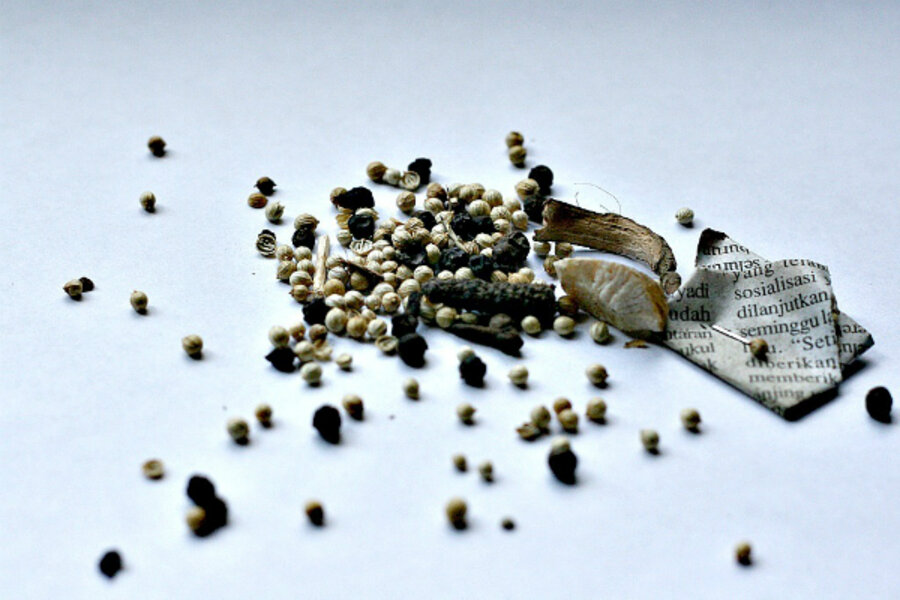How to make homemade spice blends
A few years ago, my cousin gave me several packets of a spice mix from Bali, Indonesia. The small, clear packets contained an assortment of whole spices including coriander, black pepper, long pepper, cloves and what I believed were slices of dried kencur (zedoary, curcuma species). Also in each packet was a mysterious powder (it looked like ground spices but I had no idea what!), folded into a small square of old newspaper and stapled shut. Even my cousin didn’t know what it was or what culinary magic it might impart.
Buoyed by blind faith, I followed my cousin’s instructions to crush the spices with a mortar and pestle and fry the powder till fragrant before simmering pork chunks in coconut milk. The resulting dish was aromatic and succulent, bringing me back to long, languid summer visits to Indonesia. I’ve gone on to use the spice mixture as a rub for pork ribs as well as a seasoning for chicken, all with excellent results.
When I ran out, I was devastated. Not for very long though. I figured: someone created the spice combination from scratch and so could I.
A little bit of this, a little bit of that, and it came together. Okay, so it wasn’t really that simple (plus, no mysterious powder!) but after a few trials and errors, I conjured up a similar facsimile that was just as tasty.
Then I started thinking, why not make all my favorite spice blends from scratch: garam masala, taco seasoning, shichimi togarashi, Cajun spice, pumpkin spice seasoning, etc. All of these blends are easy enough to make at home using organic, non-irradiated spices without any additives.
In developing my own spice mixtures, I came up with some tips for blending spices at home:
- Don’t be afraid to substitute
Google and you’ll find tons of spice blend recipes on the internet. I guarantee you’ll find one that you really want to try that calls for, say cubeb berries (I know, what the…?). But you don’t have cubeb berries in your pantry, you can’t find cubeb berries at the local Safeway, and even if you did find some, would you use it again? Google again, and you’ll find out that, while they possess a slight pine-like pungency and have a subtle allspice flavor, cubeb berries share black pepper’s flavor profile. Go ahead and substitute, tweaking the final mix to your liking, perhaps adding some allspice. Spice blends are about the flavors you like, not someone else, including the person who created the original recipe!
- Start small
Spice blends straight up will not taste the same as in the final dish, i.e. you can’t dip your finger in it and deduce it’ll taste good. To really test drive the blend, you’ll have to cook your dish. That’s why, start with small quantities first. Once you’ve come up with the perfect balance of spices, make a larger batch so it’ll be handy-dandy, but not so much that you won’t use it up within a few months.
- Buy from the bulk bins
Spices, especially when ground, lose their flavor after several months sitting in your kitchen cabinet. A good rule of thumb is to toss them out after 6 to 8 months, or do the smell test. If they smell of dust and nothing else, out it goes. Buy from bulk bins, buy whole spices if you can, and only buy what you need.
- Clean your pantry
Just like cleaning out your closet, there’s so much satisfaction to be gained from ridding your pantry of spices (and other foodstuffs) that haven’t seen the light of day since, oh I don’t know, the early 2000′s? Be brave, say goodbye to that bottle of berbere spice you received as a hostess gift at that long-ago dinner party. You’ll free up room for the spices you really want to stock up on!
- Be adventurous
Invent your own spice blend using spices/flavors you love! I was captivated by a chicken dish an acquaintance made for me years ago. I deduced the spices included turmeric, tarragon, and mint, all flavors I enjoy, and kept experimenting until I came up with something vaguely similar. I don’t believe there are any hard and fast rules about blending spices. When it comes to combining flavors, go with your gut. Of course, you don’t want one spice to overpower all the other flavors so balance is important. Just go easy on the more pungent spices like anise, cumin, peppers, and even rosemary.
In no time, you’ll be a masalchi just like my friend Rick’s Aunty Kaisrie (below)!
Aunty Kaisrie’s Spice Blend (Masala)
From "The Asian Grandmothers Cookbook – Home Cooking from Asian American Kitchens" (Sasquatch Books, 2009)
Masala – the Hindi word for a blend of spices – is at the heart of Indian cooking. Rick’s Aunty Kaisrie is the family masalchi, or spice-blender. A masala can comprise just two or three spices or up to a dozen or more and it may be added whole or ground and at different stages of cooking. The popular garam masala is a blend of savory aromatic spices added near the end, or at the end, of cooking when making curries. The following spices are available at South Asian markets and in the bulk section of gourmet markets. To make a larger or lesser amount of this blend, increase or decrease the ingredients in proportion to one another.
Time: 45 minutes
Makes: 3/4 cup
2-inch stick cinnamon, broken up
1 tablespoon black onion seeds
1 tablespoon black peppercorns
2 tablespoons cardamom seeds
1/4 cup aniseed
1/4 cup black mustard seeds
1/4 cup fenugreek seeds
1/4 cup cumin seeds
1. In a medium cast-iron skillet, dry roast the spices one at a time over medium heat, stirring until they turn a few shades darker and release a musky aroma. Transfer to separate plates as they are roasted and let cool.
2. Each spice takes varying lengths of time to roast so pay careful attention not to burn them. Grind the spices separately in a clean coffee or spice grinder until powdery. Combine and sift all the spices together. Store the masala in an airtight jar for 2 to 3 months.
Related post on Pickles and Tea: Homemade pad Thai sweet and sour sauce







